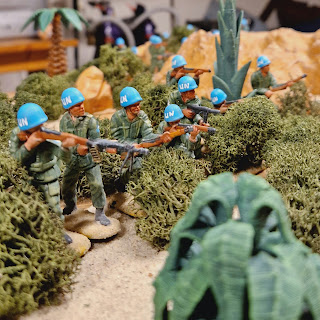One of the nice things with writing this blog are all you people who reads it, and sometimes comments on my posts. Especially appreciated are comments which points me into new rules or aspects of wargaming.
After writing a review on Donald Featherstone's 'Close Wars', John Yorio from the excellent blogg '54mm or Fight' suggested another Donald Featherstone's rules; 'War Games or Battles with Models Soldiers' as an alternative for simple rules in a more modern setting with heavier weapons. This was also encouraged by Mark from the excellent 'Man of Tin blog'. Links to both of these inspiring blogs are found in the bar to the right and below in the link-sections (and if you haven't been there yet, pay them a visit). John even provided me of a copy of the 3 short pages of Donald Feathersone's rules. So I decided I had to try them out. Wow! What a society!!
The scenario
- Katangese:
- 2 rifle-squads each of 10 soldiers, a LMG and and a bazooka/flame thrower. Each squad can operate as 2 fireteams independently.
- 1 HMG-detachment of 3 soldiers
- 1 sniper
- HQ-section with platoon-leader and 2 medics
- After turn 12 if rules include vehicles or skilled troops: A QRF consisting of 1 truck with a HMG and a section of 10 'veterans' with a LMG and a bazooka arrives from the next village. Only if Lumbaya is still held by Katangese forces.
- UN:
- Katangese: To hold the strongpoint of Lumbaya. Can request QRF-support as mentioned in the force-section from turn 12 if still holding whole or part of the strongpoint.
- UN: To take and hold the strongpoint of Lumbya, preferably within 12 turns, and take control on as many Katangese gendarms located there as possible.
AAR
... and gave the UN the needed initiative in the battle.
When getting closer to the village the UN forces met more resistance and heavier fire, and their jeep and HMG were eventually taken out by a Katangese LMG, but not before...
...the UN support weapons made to tear up the Katangese line of defense completely...
...and the Katangese reserves didn't even make it to their defense line before they were under heavy fire and taken out by another successful UN-mortar grenade.
In turn 8 the first UN squads were entering the village. The Katangese had only one team and surprise left for the entering UN-troops, a 'secret weapon'.
...Until it malfunctioned in the next turn (because you just don't miss with a weapon like this), and another UN squad came to the rescue. By this time there were only 2 unarmed Katangese medics left in the village, and an UN success with minimal losses (just a jeep and 4 plastic grunts).
Pros
- It's simple and can be played with easily available and cheap army men or toy soldiers from a lot of different (modern-) periods.
- Fast playing.
Cons
- These rules are really simple. Perhaps too simple. In only 3 small pages there are minimal information which may lead to misinterpretations.
- Even if the rules were short they were contradictory on the rifle ranges. One place it was written that the rifle range was 12", and on another thet you had to deduct '3' from your dice if firing rifles on ranges between 12"-24". I went for the long range alternative as I think the firing range for infantry weapons are a little too short.
- There were no clear turn sequence, so I decided to play is at 'I go, You go'.
- Even if it contains rules for a lots of special weapons, it doesn't have any rules for sniper rifles. It didn't matter much in my game anyway, because my 'sniper' (which I treated as a infantry man with long range) was only rolling '1's every time.
- In this game you don't roll a dice (or more) for each weapon. Infantry units fire 1 D6 for each volley of 5 men. - and deduct numbers from your dice depending on the range. The units under fire makes a roll for a save thou. So some calculation is needed when not operating 5-men teams or teams divisible by 5. It also makes it very difficult for smaller units to hit anything at all.






















































.jpg)






